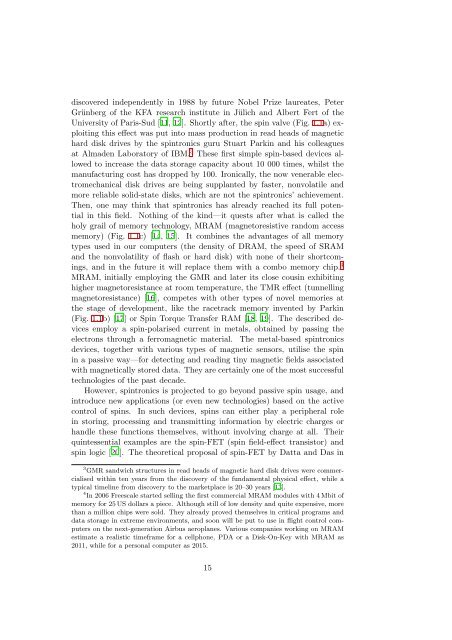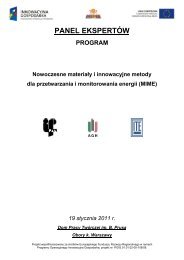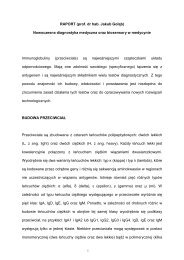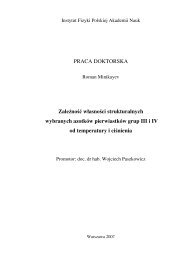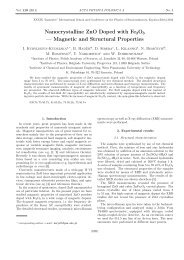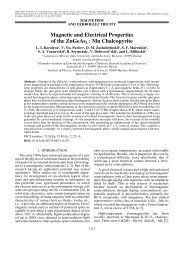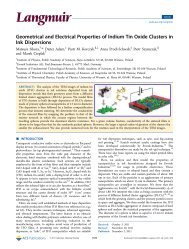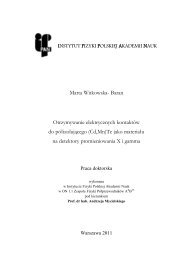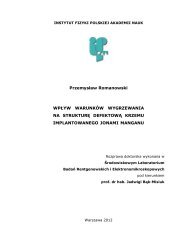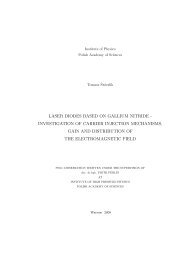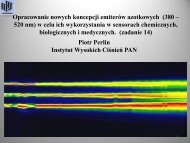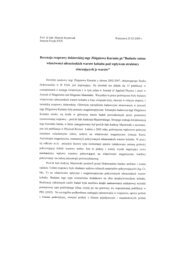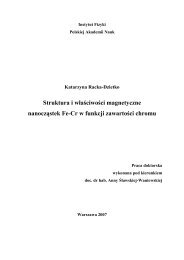Spin waves and the anomalous Hall effect in ferromagnetic (Ga,Mn)As
Spin waves and the anomalous Hall effect in ferromagnetic (Ga,Mn)As
Spin waves and the anomalous Hall effect in ferromagnetic (Ga,Mn)As
Create successful ePaper yourself
Turn your PDF publications into a flip-book with our unique Google optimized e-Paper software.
discovered <strong>in</strong>dependently <strong>in</strong> 1988 by future Nobel Prize laureates, PeterGrünberg of <strong>the</strong> KFA research <strong>in</strong>stitute <strong>in</strong> Jülich <strong>and</strong> Albert Fert of <strong>the</strong>University of Paris-Sud [11, 12]. Shortly after, <strong>the</strong> sp<strong>in</strong> valve (Fig. 1.1a) exploit<strong>in</strong>gthis <strong>effect</strong> was put <strong>in</strong>to mass production <strong>in</strong> read heads of magnetichard disk drives by <strong>the</strong> sp<strong>in</strong>tronics guru Stuart Park<strong>in</strong> <strong>and</strong> his colleaguesat Almaden Laboratory of IBM. 3 These first simple sp<strong>in</strong>-based devices allowedto <strong>in</strong>crease <strong>the</strong> data storage capacity about 10 000 times, whilst <strong>the</strong>manufactur<strong>in</strong>g cost has dropped by 100. Ironically, <strong>the</strong> now venerable electromechanicaldisk drives are be<strong>in</strong>g supplanted by faster, nonvolatile <strong>and</strong>more reliable solid-state disks, which are not <strong>the</strong> sp<strong>in</strong>tronics’ achievement.Then, one may th<strong>in</strong>k that sp<strong>in</strong>tronics has already reached its full potential<strong>in</strong> this field. Noth<strong>in</strong>g of <strong>the</strong> k<strong>in</strong>d—it quests after what is called <strong>the</strong>holy grail of memory technology, MRAM (magnetoresistive r<strong>and</strong>om accessmemory) (Fig. 1.1c) [14, 15]. It comb<strong>in</strong>es <strong>the</strong> advantages of all memorytypes used <strong>in</strong> our computers (<strong>the</strong> density of DRAM, <strong>the</strong> speed of SRAM<strong>and</strong> <strong>the</strong> nonvolatility of flash or hard disk) with none of <strong>the</strong>ir shortcom<strong>in</strong>gs,<strong>and</strong> <strong>in</strong> <strong>the</strong> future it will replace <strong>the</strong>m with a combo memory chip. 4MRAM, <strong>in</strong>itially employ<strong>in</strong>g <strong>the</strong> GMR <strong>and</strong> later its close cous<strong>in</strong> exhibit<strong>in</strong>ghigher magnetoresistance at room temperature, <strong>the</strong> TMR <strong>effect</strong> (tunnell<strong>in</strong>gmagnetoresistance) [16], competes with o<strong>the</strong>r types of novel memories at<strong>the</strong> stage of development, like <strong>the</strong> racetrack memory <strong>in</strong>vented by Park<strong>in</strong>(Fig. 1.1b) [17] or <strong>Sp<strong>in</strong></strong> Torque Transfer RAM [18, 19]. The described devicesemploy a sp<strong>in</strong>-polarised current <strong>in</strong> metals, obta<strong>in</strong>ed by pass<strong>in</strong>g <strong>the</strong>electrons through a <strong>ferromagnetic</strong> material. The metal-based sp<strong>in</strong>tronicsdevices, toge<strong>the</strong>r with various types of magnetic sensors, utilise <strong>the</strong> sp<strong>in</strong><strong>in</strong> a passive way—for detect<strong>in</strong>g <strong>and</strong> read<strong>in</strong>g t<strong>in</strong>y magnetic fields associatedwith magnetically stored data. They are certa<strong>in</strong>ly one of <strong>the</strong> most successfultechnologies of <strong>the</strong> past decade.However, sp<strong>in</strong>tronics is projected to go beyond passive sp<strong>in</strong> usage, <strong>and</strong><strong>in</strong>troduce new applications (or even new technologies) based on <strong>the</strong> activecontrol of sp<strong>in</strong>s. In such devices, sp<strong>in</strong>s can ei<strong>the</strong>r play a peripheral role<strong>in</strong> stor<strong>in</strong>g, process<strong>in</strong>g <strong>and</strong> transmitt<strong>in</strong>g <strong>in</strong>formation by electric charges orh<strong>and</strong>le <strong>the</strong>se functions <strong>the</strong>mselves, without <strong>in</strong>volv<strong>in</strong>g charge at all. Theirqu<strong>in</strong>tessential examples are <strong>the</strong> sp<strong>in</strong>-FET (sp<strong>in</strong> field-<strong>effect</strong> transistor) <strong>and</strong>sp<strong>in</strong> logic [20]. The <strong>the</strong>oretical proposal of sp<strong>in</strong>-FET by Datta <strong>and</strong> Das <strong>in</strong>3 GMR s<strong>and</strong>wich structures <strong>in</strong> read heads of magnetic hard disk drives were commercialisedwith<strong>in</strong> ten years from <strong>the</strong> discovery of <strong>the</strong> fundamental physical <strong>effect</strong>, while atypical timel<strong>in</strong>e from discovery to <strong>the</strong> marketplace is 20–30 years [13].4 In 2006 Freescale started sell<strong>in</strong>g <strong>the</strong> first commercial MRAM modules with 4Mbit ofmemory for 25US dollars a piece. Although still of low density <strong>and</strong> quite expensive, morethan a million chips were sold. They already proved <strong>the</strong>mselves <strong>in</strong> critical programs <strong>and</strong>data storage <strong>in</strong> extreme environments, <strong>and</strong> soon will be put to use <strong>in</strong> flight control computerson <strong>the</strong> next-generation Airbus aeroplanes. Various companies work<strong>in</strong>g on MRAMestimate a realistic timeframe for a cellphone, PDA or a Disk-On-Key with MRAM as2011, while for a personal computer as 2015.15


